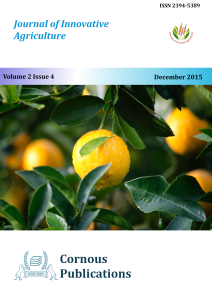Cabbage is one of the most popular winter cruciferous vegetables grown in India. It is mostly cultivated in cool places and hence, the crop is mostly affected by Xanthomonas campestris pv. campestris (Xcc) (Pammel) causes black rot disease worldwide. Increased usage of different chemicals based products to control these pathogens have resulted in problems like residual effect of chemicals in agri-based products and also increased resistance for chemicals in target pathogens and environmental pollution. The crude extracts of some well-known botanicals, biocontrol agents and organic amendments are used to control some of the plant pathogens. The results of botanicals the leaf extract of Datura stramonium (10%) was maximum inhibition and minimum inhibition of Ocimum basilicum were recorded. Whereas, the biocontrol agents of Streptomyces spp and Trichoderma viride showed maximum inhibition zone were effective against the growth of Xcc.
Two field experiments on okra (Cv: Shakti) were conducted, at Nathapatti (I season : July 2012 to October 2012) and Pazhayasukkampatti (II season : December 2012 to March 2013) of Tamil Nadu to evaluate the safety of new formulation Emamectin benzoate 5 WG at different doses (100, 125 and 150 g/ha) against the standard check, Emamectin benzoate 5 SG (135 and 170 g/ha), Lambda cyhalothrin 5 CS (300 ml/ha) and Pyridalyl 10 EC at 500 ml/ha for their safety to coccinellid predators in okra eco-system. Observation on the population of coccinellid was recorded prior to spraying and at 5 and 10 days after each spraying from ten randomly selected plants in each replication and untreated check. The results showed that Emamectin benzoate 5 WG was found to be safer to coccinellidat all concentrations tested. The highest population recorded in plots treated with Emamectin benzoate 5 WG at 100 g/ha followed by Emamectin benzoate 5 WG at 125 g/ha, respectively.
